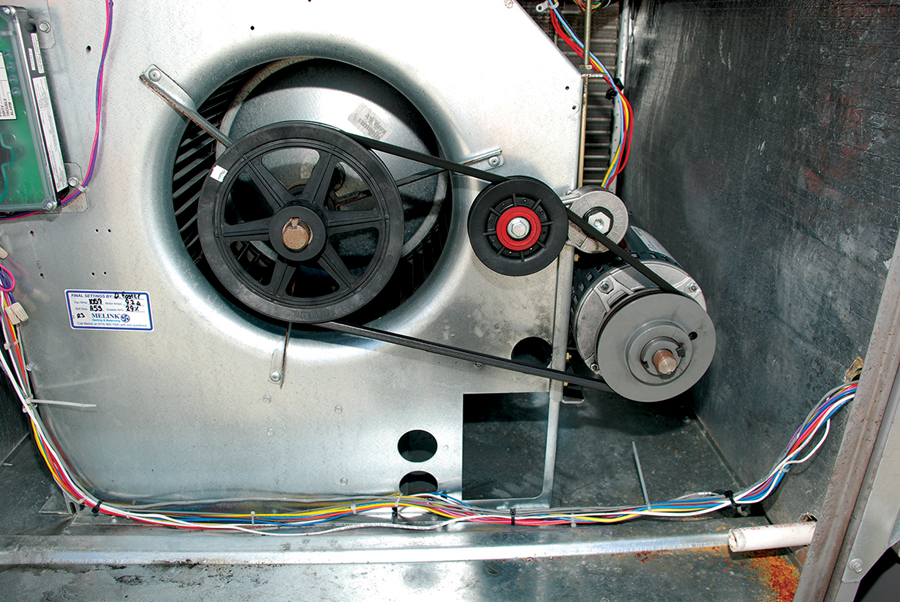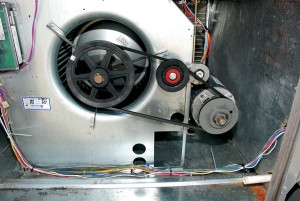
Relieving the tension
With the recent focus by the heating, ventilation and air-conditioning (HVAC) industry on green initiatives, the subject of V-belt drive efficiency has garnered much attention. Despite a lack of hard data, it is common knowledge among HVAC...
June 1, 2013 | By By Jeremy Bigler and Stephen Heston
 Photo: Fenner Drives. In the field, belt drives are not optimally designed, nor well maintained. In these systems, installing a T-Max Belt Tensioner can result in significant energy savings.
Photo: Fenner Drives. In the field, belt drives are not optimally designed, nor well maintained. In these systems, installing a T-Max Belt Tensioner can result in significant energy savings. 
Photo: Fenner Drives. In the field, belt drives are not optimally designed, nor well maintained. In these systems, installing a T-Max Belt Tensioner can result in significant energy savings.
With the recent focus by the heating, ventilation and air-conditioning (HVAC) industry on green initiatives, the subject of V-belt drive efficiency has garnered much attention. Despite a lack of hard data, it is common knowledge among HVAC professionals that proper V-belt tension is critical not only to belt life, but also to optimal drive function.
In order to add rigorous empirical data to this subject, Fenner Drives constructed a dynamometer test cell to measure the true impact of belt tension on HVAC fan systems. The test cell incorporated two identical, but fully independent, HVAC fan and measurement systems. Centrifugal blowers were used to provide the variable load, and high-accuracy sensors captured power readings at each energy conversion point.
The results show that even in properly designed, well-maintained belt drives, tension decay causes efficiency losses. The results also show that these losses are largely eliminated with the use of a T-Max Belt Tensioner.
(Editor’s Note: Because of space limitations, the four charts that are referenced below can be found online in the Feature Stories section of our website at www.mromagazine.com.)
Chart 1 displays the typical degradation in performance observed in several brands of rubber V-belts as tension was reduced. These trends represent the combined data from many trials with each brand of rubber belt.
It is evident that losses in belt tension correlate to reductions in drive efficiency. For a fan system controlled to a fixed motor speed, the reduction in drive efficiency causes a reduction in speed of the fan shaft and thus, a corresponding reduction in air flow. This is also shown in Chart 1 (online).
However, in systems controlled to a constant flow rate or static pressure, the reduction in drive efficiency results in an increase in power consumption as the system works harder to maintain the same air flow.
In order to estimate the energy loss in a given system, the time rate of tension decay must be known. Chart 2 (online) represents a typical maintenance schedule for an HVAC system where the V-belt is re-tensioned every six months. The shape and slope of the linear tension/time curve shown in the chart result from multiple long-term tests conducted in the Fenner Drives’ cell. As belt tension decays over the course of six months, the drive efficiency decreases from approximately 95% to 91%.
The increase in power consumption required to maintain airflow as belt drive efficiency decreases is shown in Chart 3 (online). As can be seen, the drive efficiency and power consumption return to the optimal level when the belt is re-tensioned.
A T-Max Belt Tensioner prevents tension decay from occurring in the drive and thus, maintains peak efficiency for the entire year. In Chart 4 (online), the shaded area represents wasted energy (energy that can be saved by installing a T-Max Belt Tensioner). In this test case, the shaded area accounts for an annual energy savings of 1.9%. In the field, the expected energy savings for well-maintained and well-designed drives is between 1% and 3%. But in most cases, belt drives are not optimally designed, nor well maintained. In these systems, installing a T-Max Belt Tensioner can result in significantly higher energy savings. MRO
Jeremy Bigler and Stephen Heston of Fenner Drives originally prepared this article as a white paper for the company and it is published here with permission. For more information, visit www.fennerdrives.com.
Online Reader Inquiry No. 504
